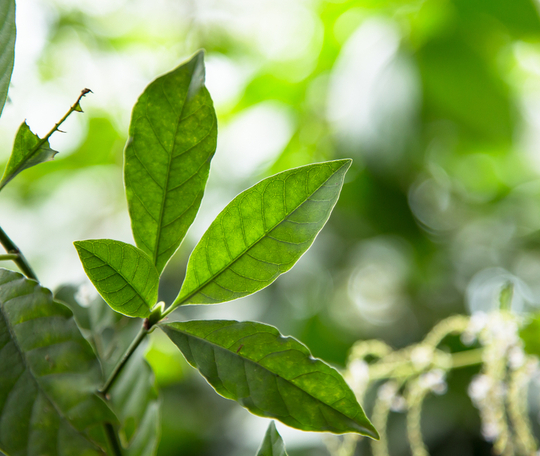PHARMACOLOGY PROFILES
DMT
N,N-Dimethyltryptamine
C12H16N2
Drug Classification
Tryptamine
Common Names
N,N-DMT, “The Spirit Molecule”
Binomial Nomenclature
Psychotria viridis (chacruna), Mimosa hostilis (jurema preta), Acacia confusa

Psychotria viridis (chacruna)

Mimosa hostilis (jurema preta)

Acacia confusa
Overview
DMT, N,N-dimethyltryptamine, occurs naturally in many plants and is hypothesized
to be endemic to animals as well. It is the active hallucinogenic compound in ayahuasca and
establishes the prototypical framework that other psychedelic tryptamines, such as psilocybin,
adhere to. Through ayahuasca rituals, DMT has been used for centuries by indigenous tribes for
healing and spiritual awakenings ceremonies. Though there is not much formal research on the
therapeutic effects of DMT, there are plenty of anecdotal reports expressing the important
connection between the substance and self-awareness, as well as powerful personal insights.
Naturally occurring DMT has been found in our brain, blood, and urine, indicating our bodies have the
ability to readily metabolize it. According to research, the compound is an important factor in
certain processes that take place in our central and peripheral nervous systems. Over the years,
studies have also shown that DMT produces an anti-depressant quality that can result in tremendous
therapeutic improvements in the well-being of adults.
From 1990 to 1995, American clinical associate and New Mexico professor of psychiatry Rick Strassman
led a study on the effects of DMT— the first government-funded clinical research in 20 years on the
effects a psychedelic substance has on human subjects. Due to the god- or spirit-like hallucinations
and overall religious experience it produced, Strassman dubbed DMT as the “spirit molecule.” In
2000, Strassman published the book, DMT: The Spirit Molecule, in which he describes his studies and
gives detailed accounts of his sessions with 60 volunteers. It was from this research that many
proposed hypotheses were hastily accepted as conclusions, including the connection that endogenous
DMT is produced in the pineal gland as well as the rumor that DMT is intrinsically present in every
plant and animal on Earth. These assumptions made their way into the mainstream narrative and have
since been intertwined with multiple amateur hypotheses concerning everything from bodily production
and utilization during endogenous processes, to extremely fringe conjectures of lost knowledge and
past societies’ spotlighting of the pineal’s integral role in our species’ history represented
through hieroglyphics. Though DMT can be found in a wide variety of organisms and recent research
suggests it might be produced in the human brain, both assumptions have yet to be proven correct.
It is highly recommended to use harm reduction practices if using this substance.
Dose and Duration
When taken at low doses, DMT will primarily affect one’s emotional and physical state. DMT’s
psychedelic effects will typically occur when taking moderate to high doses.
The general recommended dose for DMT is as follows:
- Low: 10 – 20 mg
- Medium: 20 – 40 mg
- Strong: 40 – 60 mg
- Heavy: 60+ mg
The effects of DMT should last between 15 to 20 minutes, with after effects lasting up to an hour
after return to baseline.
Effects
DMT’s psychedelic experience is attributed to the way it affects the 5-HT2A receptor. It does affect
other receptors, such as dopamine and sigma receptors, but the result of these interactions are not
well researched at this time.
At threshold levels, most biological effects are detectably altered. For example, adrenocorticotropin
hormone, beta-endorphin prolactin, and growth hormone levels will all become elevated.
The body does not build a tolerance to DMT and there is no dampening of effects or long recovery
period associated with high levels of use.
Experience
DMT is not to be confused with 5-MeO-DMT, another powerful hallucinogenic substance, considering the
two tryptamines are in fact quite different. Very rudimentarily put, while both tryptamines produce
feelings of interconnectedness and unexplainable spiritual experiences, DMT is known to cause more
of a notable visual shift, whereas 5-MeO-DMT produces more of a perceptual schism. The experience of
(multiple hits of) DMT can be described as a fast-acting feeling of euphoria, similar to other
tryptamine onsets, with a noticeably swift rush of visual and auditory distortions and
hallucinations, geometric and mechanical fractals, intense immersion, and (if enough is consumed) a
possible “breaking through” past the initial distortionary onset and into different realms or what
seems like piercing the veils of other dimensions. This phenomenon of “breaking through” the
fractals points to a higher level of the experience where the possibility of meeting other entities
has been reported as far back as the earliest known accounts of ayahuasca use. This ultimate
displacement is where users feel as if they have been transported to spiritual realms or alternate
dimensions. The effects of these two tryptamines can be described as similar but different, with
N,N-DMT having a tendency to overwhelm the senses and be difficult to remember or integrate upon
return to baseline.
Other shared experiences include:
- Spatial Disorientation
- Color Tinting or Shifting
- Delusion
- Multiple Thought Streams
- Auditory Enhancement
- Synesthesia
- Distortion of Time
The effects of DMT can last up to 20 minutes, with after effects lasting up to one hour.
Benefits
DMT is found in the brain and plays an important role in various processes taking place in the
central and peripheral nervous systems. In recent years, research and studies have shown that the
antidepressant quality of DMT can result in tremendous improvements in the well-being of adults.
In a study conducted with rats, results found that microdosing DMT can lead to lower levels of
anxiety and depression.
Risks
As with any substance, there comes a risk with DMT. Sometimes hallucinations are too intense and
overwhelming for some users, causing them to lose connection with themselves and produce symptoms of
depersonalization. While this is generally a desirable trait associated with the experience, it can
be too overwhelming for some users’ liking. DMT can also be potentially harmful if integrated with
other drugs or substances.